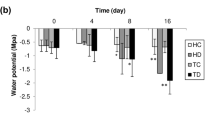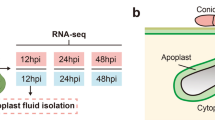Abstract
Anthracnose is a major disease in Florida hybrid bunch grapes, caused by a fungus viz. Elsinoe ampelina. Florida hybrid bunch grapes are grown in southeastern USA for their superior wine characteristics. However, the effect of anthracnose on grape productivity and wine quality is a major concern to grape growers. Our research is aimed at determining biochemical basis of anthracnose tolerance in Florida hybrid bunch grape. Leaf samples were collected from the plants infected with E. ampelina at different periods and analyzed for differential protein expression using high throughput two-dimensional gel electrophoresis. Among the 32 differentially expressed leaf proteins, two were uniquely expressed in tolerant genotypes in response to E. ampelina infection. These proteins were identified as mitochondrial adenosine triphosphate synthase and glutamine synthetase, which are known to play a major role in carbohydrate metabolism and defense. Several proteins including ribulose 1-5 bisphosphate-carboxylase involved in photosynthesis were found to be suppressed in susceptible genotypes compared to tolerant genotypes following E. ampelina infection. The results indicate that the anthracnose-tolerant genotypes have the ability to up-regulate and induce new proteins upon infection to defend the invasion of the pathogen as well as maintain the normal regulatory processes.


Similar content being viewed by others
Abbreviations
- HPLC:
-
High performance liquid chromatography
- LC/MS/MS:
-
liquid chromatography/mass spectrometry/mass spectrometry
- NCBI:
-
National Center for Biotechnology Information
- 2-D:
-
two-dimensional electrophoresis
References
Gray, D. (2003). New plants for Florida: Grape. Circular 1440. In R. L. Jones, M. L. Duryea, & B. J. Treat (Eds.), Florida agricultural experiment station. Gainesville: Institute of Food and Agricultural Sciences, University of Florida.
Lu, J. (2003). SRASHS Symposium. Mobile, Alabama, Feb 3, 2003.
Berger, S., Benediktyova, Z., Matous, K., Bonfig, K., Mueller, M. J., Nedbal, L., et al. (2007). Journal of Experimental Botany, 58(4), 797–806. doi:10.1093/jxb/erl208.
Dixon, R. A., Harrison, M. J., & Lamb, C. J. (1994). Annual Review of Phytopathology, 32, 479–501. doi:10.1146/annurev.py.32.090194.002403.
Benhamou, N. (1996). Trends in Plant Science, 1, 233–240.
Uritani, I. (1969). International Botanical Congress, 11, 224.
Omari, B. L., Fleck, I., Aranda, X., Moret, A., & Nadal, M. (2001). Annals of Forest Science, 58, 165–173. doi:10.1051/forest:2001116.
Niederleitner, S., & Knoppik, D. (1997). Physiological and Molecular Plant Pathology, 51(3), 145–153. doi:10.1006/pmpp.1997.0097.
Bradford, M. M. (1976). Analytical Biochemistry, 72, 248–254. doi:10.1016/0003-2697(76)90527-3.
Laemmli, U. K. (1970). Nature, 227, 680–685. doi:10.1038/227680a0.
Basha, S. M. (1979). Plant Physiology, 63, 301–306.
Ren, Z., & Lu, J. (2002). Proceedings of the Florida State Horticultural Society, 115, 108–110.
Kim, S. T., Cho, K. S., Yu, S., Kim, S. G., Hong, J. C., Han, C., et al. (2003). Proteomics, 3, 2368–2378. doi:10.1002/pmic.200300577.
Vidhyasekaran, P. (1997). Fungal pathogenesis in plants and crops: molecular biology and host defense mechanisms. New York: Marcel Dekker.
Miller, R. J., & Koeppe, D. E. (1971). Science, 173, 67–69. doi:10.1126/science.173.3991.67.
Koeppe, D. E., Cox, J. K., & Malone, C. P. (1978). Science, 201, 1227–1229. doi:10.1126/science.201.4362.1227.
Berville, A., Ghazi, A., Charbonnier, M., & Bonavent, J. F. (1984). Plant Physiology, 76, 508–517.
Holden, M. J., & Sze, H. (1984). Plant Physiology, 75, 235–237.
Batchvarova, R. B., Reddy, V. S., & Bennett, J. (1992). Phytopathology, 82, 642–646. doi:10.1094/Phyto-82-642.
Ishiyama, K., Inoue, E., Tabuchi, M., Yamaya, T., & Takahashi, H. (2004). Plant & Cell Physiology, 45(11), 1640–1647. doi:10.1093/pcp/pch190.
Mifflin, B. J., & Lea, P. J. (1980). The biochemistry of plants, amino acids and derivatives. In B. J. Miflin (Ed.), (pp. 169–202). New York: Academic.
Pageau, K., Cren, M. R., Gaudry, J. F. M., & Daubresse, C. M. (2006). Journal of Experimental Botany, 57(3), 547–557. doi:10.1093/jxb/erj035.
Hoffland, E., Jeger, M. G., & Van Beusichem, M. L. (2000). Plant and Soil, 218, 239–247. doi:10.1023/A:1014960507981.
Long, D. H., Lee, F. N., & TeBeest, D. O. (2000). Plant Disease, 84, 403–409. doi:10.1094/PDIS.2000.84.4.403.
Solomon, P. S., Tan, K. C., & Oliver, R. P. (2003). Molecular Plant Pathology, 4, 203–210. doi:10.1046/j.1364-3703.2003.00161.x.
Turner, J. G., & Debbage, J. M. (1982). Physiological Plant Pathology, 20, 223–233. doi:10.1016/0048-4059(82)90087-X.
Bender, C. L., Alarcon-chaidez, F., & Gross, D. C. (1999). Microbiology and Molecular Biology Reviews, 63, 266–292.
Mullineaus, P. M., & Rausch, T. (2005). Photosynthesis Research, 86, 459–474. doi:10.1007/s11120-005-8811-8.
Yu, C. L., Yan, S. P., Wang, C. C., Hu, H. T., Sun, W. N., Yan, C. Q., et al. (2008). Photochemistry, 69, 1989–1996. doi:10.1016/j.phytochem.2008.04.006.
Salvucci, M. E., DeRidder, B. P., & Portis Jr., A. R. (2006). Journal of Experimental Botany, 57, 3793–3799. doi:10.1093/jxb/erl140.
Thomas, R., Gordon, R., & Duniway, J. M. (1982). Plant Physiology, 69(1), 139–142.
Ranty, B., Roby, D., Cavalié, G., & Tugayé, M. T. E. (1987). Planta, 170(3), 386–391. doi:10.1007/BF00395031.
Pinkard, E. A., & Mohammed, C. L. (2006). The New Phytologist, 170, 119–127. doi:10.1111/j.1469-8137.2006.01645.x.
Berger, S., Papadopoulas, M., Schreiber, U., Kaiser, W., & Roitsch, T. (2004). Physiologia Plantarum, 122(4), 419–428. doi:10.1111/j.1399-3054.2004.00433.x.
Mahmood, T., Jan, A., Kakishima, M., & Komatsu, S. (2006). Proteomics, 6, 6053–6065. doi:10.1002/pmic.200600470.
Tsunezuka, H., Fujiwara, M., Kawasaki, T., & Shimamoto, K. (2005). Molecular Plant–Microbe Interactions, 18, 52–59. doi:10.1094/MPMI-18-0052.
Acknowledgments
We thank Dr. Breno Leite, Plant Pathologist, Florida A & M University for his assistance in isolating the pure cultures of E. ampelina, Ms. Anse Kaplan for her assistance in running two-dimensional gel electrophoresis, Dr. Barbara J. Smith, Research Plant Pathologist, USDA–ARS Southern Horticultural Laboratory, Poplarville MS for reviewing the paper, and Dr. Scott McClung and Dr. Sophie Alvarez, Proteomics Core of the ICBR Gainesville FL, for protein sequencing and analysis. We also acknowledge the Florida Grape Growers Association and the Florida Department of Agriculture for their financial support.
Author information
Authors and Affiliations
Corresponding author
Rights and permissions
About this article
Cite this article
Vasanthaiah, H.K.N., Katam, R. & Basha, S.M. Characterization of Unique and Differentially Expressed Proteins in Anthracnose-Tolerant Florida Hybrid Bunch Grapes. Appl Biochem Biotechnol 157, 395–406 (2009). https://doi.org/10.1007/s12010-008-8380-3
Received:
Accepted:
Published:
Issue Date:
DOI: https://doi.org/10.1007/s12010-008-8380-3




